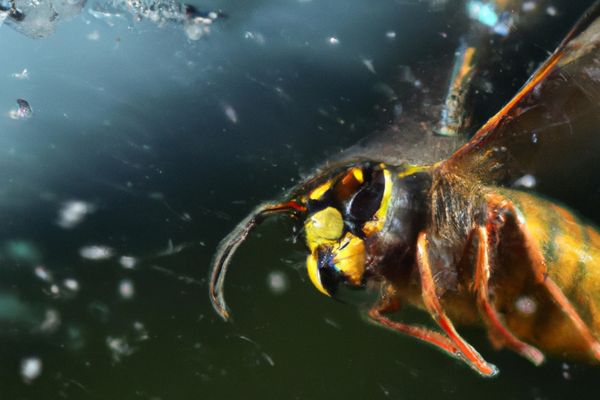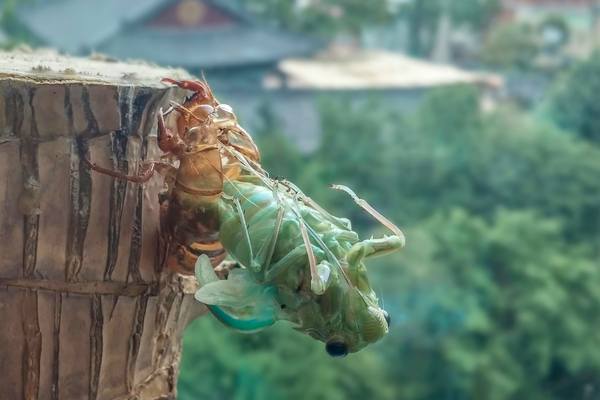Many have wondered just how well insects do in the rain, especially when they are flying. Do they just get bombed by a raindrop and get killed or mortally injured? If not, how do they avoid harm?
Insects have a variety of strategies for dealing with rain, from flying in it to taking cover. Their ability to fly in the rain is due to their water-repellant hairs and wings, which help them avoid getting wet. Mosquitoes seem to be especially adept at flying in the rain and their small size is part of their advantage.
Whereas direct evidence is hard to record, in-flight experiments with wet wings and a field of drops have shed light on this question.
But first, let’s get this out of the way. While many people call all insects “bugs,” the order of true bugs is distinguished by the insect having two pairs of wings, the outer pair being leathery as protection (like most beetles), and the inner pair being the clearer part that actually supports the flight.
Here we will use the word “bugs” and “insects” interchangeably as bugs are insects, but not all insects are bugs! I wrote a bit more about their evolutionary history, and why some people call crabs and lobsters bugs too, in my recent blog post.
Contents
Can bugs fly with wet wings?
No, they cannot, but their wings are designed (with a kind of nanotechnology!) such that they will never get wet, so they can indeed fly in the rain!
However, insects usually take some kind of cover during a rainstorm. If their wings were to get wet they can stick together, but it does not happen.
In addition, many rainstorms include higher wind speeds, so most insects just hunker down and wait it out.
Also, if the body gets wet, the insect weighs more, making flight harder to achieve, so evolution has also made sure this does not happen.
Most insects, however, have microscopic, water-repellant hairs on their bodies, even if you can’t see them readily.

These hairs help keep the insect’s body from getting wet. The wings are usually designed to repel water as well, so they don’t really get wet.
The insects may lose some altitude when hit, but that may not be enough to really interrupt a flight path.
They just take the dip and fly on. If an insect is hit so that it falls to the ground, it won’t be hurt but it will just stay there under cover until the rain ends.
What insects can fly in the rain?
Larger beetles and dragonflies are better able to withstand rain impacts. They also can recover in flight more easily after a direct hit. In addition, beetles and some other insects have a hard shell covering their bodies, which can deflect a raindrop due to the water surface tension on the raindrop or even break it up, lessening the impact.
One annoying fact is that mosquitoes seem to be able to withstand actual downpours. They are so small and lightweight that they don’t slow the impact of a raindrop much, which lessens the impact of the drop on the insect.

Mosquitoes have those water-resistant hairs on their bodies, which allows them to sort of slide out from under the offending water missile.
They might get knocked down a bit, but they still keep flying. Instead of trying to hide out during the rain, they just keep right on doing what they do.
In fact, studies indicate that mosquitoes may just take advantage of rain since they can keep looking for food while any rivals are undercover.
Can hornets fly in the rain?
Hornets don’t seem to have much of a problem flying in the rain, especially the large hornet species. They seem to fly quite easily during rain.
This is due to the proportion of their bodies and the strength and speed at which they use their wings during flight.
This means that if an animal, e.g. one of many that want to eat the hornet’s larvae, gets too close to a hornet nest, even during a rainstorm, you can still be attacked.

European hornets don’t seem to be bothered much by flying in the rain, but they still will seek cover when it rains.
They are, as one of the few carnivorous insects in the world, bothered by the lack of prey during a rainstorm!
Of course, gusty winds instead of rain falling straight down might lead any insect to take cover to prevent anything inharmonious from happening.
Can yellow jackets fly in the rain?
Yellow jackets behave much as hornets do in the rain. They are too big to really be bothered by it, but they fly less.
They can fly just as well as any hornet in the rain. However, they do tend to be on the smaller side of the wasp family, so they’d rather just play it safe in their nest or under leaves or flowers until the storm passes.
Higher winds during a storm would definitely make flying a challenge for these insects.
By the way, yellow jacket underground nests can be damaged by rainfall that’s heavy enough to flow down into the nest hole, especially the newer nests that aren’t spread out very far.
Can wasps fly in the rain?
If rain begins to fall, wasps will immediately retreat to their nests. They will gather food for their larvae and pupae, and expand their nest combs for protection. While in the nest, they will also assemble and generate heat to keep warm. They will stay inside the nest until the rain stops.
It is important to avoid wasp nests if possible. These insects can easily enter your house if they find a small crack. The best way to avoid being attacked by wasps is to seal off any cracks in your home and place a wasp trap. These devices are easy to use and will significantly reduce the amount of wasps you see.
It is important to note that the temperature change caused by rain will have a dramatic effect on wasps. A drop of two degrees Celsius will have a profound effect on their activity. The change in temperature will cause them to return to their nest and wait for the next day.
Can cicadas fly in the rain?
Cicadas live the vast majority of their lives underground where they have no wings and do not fly at all.
That makes rain a very bad thing for cicadas but not because of their wings. But rain can have a big impact on their survival when the ground gets flooded, but it is rarely a problem for them because they cannot fly.
In the 10 to 20 first years of their lives, cicadas live 2 feet underground, so they do not need to fly. But when mating, they crawl up from their burrows and expose their wings that were previously hidden under a shell.

They only have a few days to fly around and reproduce, so rainfall during this time could be detrimental to them as they are not very experienced flyers!
During the rain, they hunker down under leaves, where they are protected from the elements. If the rain is heavy, they might be blown to the ground where they can be eaten by ground-dwelling predators.
But like other insects, cicadas use nanostructures on the surface of their wings to repel rain. This makes them a little difficult to replicate, but researchers have been able to create copies using nail polish and nanoimprinting lithography.
This technology could be used to make new kinds of rain jackets.
Can raindrops kill small insects like flies?
No, the smaller the insect, the less likely it is to be hit by the rain!
As has been mentioned, mosquitoes and other small insects like fruit flies seem to be oblivious to flying in the rain.
Actually, the smaller the insect, the more likely that it can avoid raindrops. Each drop displaces a bit of air out ahead of itself as it falls.
When it gets to a tiny insect, this moving air actually can push the insect out of the path of the water. In addition, those microscopic water-repellant hairs, which even tiny insects can have, do a good job of repelling the water.
Although they can avoid raindrops, smaller flies may still drown in rain deposited in pools, but they can live in water for quite some time if they do not get eaten by a fish or other animals!
The upshot is that while larger insects can better withstand a direct hit, conversely, the smaller insects are more likely to be able to be just pushed out of the way, avoiding a hit altogether.
Can flies fly in the rain?
While most insects don’t like rain, some species are capable of flying on rainy days. These types of flies have special hair that resists water. However, many species are also hampered by strong winds that often accompany storms.
To avoid these issues, bigger flies should seek shelter from the rain or wind by avoiding the most exposed areas.
Can gnats fly in the rain?
Gnats are not a single species, but a broader term for smaller flies of the “two-wing” order (flies so small they only use two wings to fly!).
There are three common types of gnats: fruit flies, fungus flies, and drain flies. All species are nuisance insects. However, fruit flies are the more common ones.
While most gnats do not eat during their brief lives, their larvae eat plants, algae, and fungus.
These insects can be a nuisance during rainy weather as they are so small that rain does not bother them much and their entire life cycle is very dependent on rain and humidity.
They can appear in large numbers and be very annoying, especially if they land on your body or breathe your air.
During rainy weather, large numbers of gnats can be attracted to light, and they can easily enter a building or home. This is because they can survive in stagnant water.
Do some insects like the rain?
Many insects like rain because it gives them water to drink and makes it easier to find food. The gnats mentioned above actually benefit more from the rain because it provides them breeding grounds and food.
Insects that live high up on plants need water to survive, and their plant food also needs that water to survive (although they likely don’t know that…). This is quite important as most insects are plant eaters!

Rain also washes away dust, urine, mites, and other particles from the insect’s bodies.
Many insects are actually more active during and immediately after rain because the moisture makes it easier for them to move around and find food.
Some insects, such as mosquitoes, need water to carry lay their eggs in and they also like to breed in still pools just after rain. All of these factors make rain an important part of the life cycle for many insects.
Where do insects go when it rains?
Some insects go underground when it rains. Some will climb up on plants or trees. Some will find a crack or hole to hide in.
Some insects, like ants and bees, will go underground to avoid rain. Others, like butterflies and beetles, will climb up on plants or trees. Flies and mosquitoes will find a crack or hole to hide in.

It all depends on the insect, its size, and where it is at the moment when it starts raining. Some insects, like the hornets, have nests or burrows that they can retreat to, while others have to find whatever shelter they can at the moment.
Conclusion
From the article, it is clear that insects have a variety of strategies for dealing with rain. Some take cover, some fly in spite of the rain, and some use their small size to their advantage. It all depends on the species of insect and the conditions of the rainstorm.
But whereas most bugs can fly in the rain, they may take cover to avoid getting wet. Smaller insects are more likely to be able to avoid raindrops altogether.
And although it might annoy them sometimes, most insects actually like the rain. The rain washes away dust and other particles from their wings that can interfere with an insect’s ability to find food or mates.




